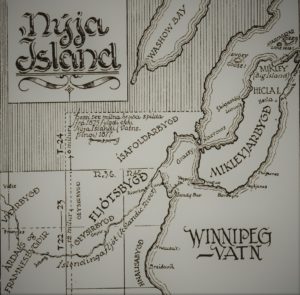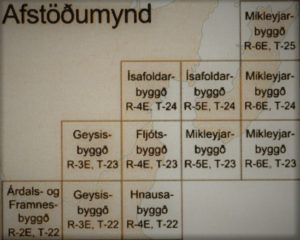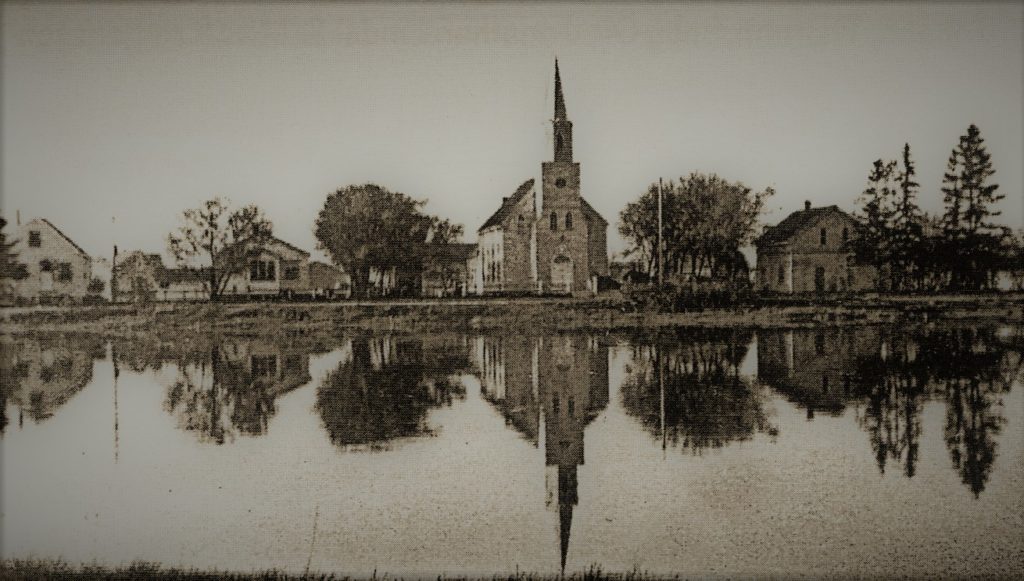 Árdal and Framnes Settlements were created around the turn of the century 1900 west of the Geysir Settlement along the Icelandic River (Íslendingafljót). In the years 1878-79, the possibility of a settlement along the Icelandic River, further west than where the Geysir Settlement was later built, was discussed. An expedition went up the river and returned to the Fljóts Settlement with positive news. However, nothing came of the survey because the stream of settlers at that time was going south, away from New Iceland. When that emigration ended around 1881, it took over a year until settlers, newcomers from Iceland, began to again study land in New Iceland. Throughout the decade, the number of settlers increased and gradually a settlement was built westwards along the Icelandic River, the Geysir Settlement was formed and in 1889, two settlers went further west, across the border of the Geysir Settlement. These were the brothers Guðmundur and Jón Magnússon Borgfjörð from Borgarhreppur in Mýrasýsla. They named their towns Melstad and Hvanneyri. They came from Iceland in 1888.
Árdal and Framnes Settlements were created around the turn of the century 1900 west of the Geysir Settlement along the Icelandic River (Íslendingafljót). In the years 1878-79, the possibility of a settlement along the Icelandic River, further west than where the Geysir Settlement was later built, was discussed. An expedition went up the river and returned to the Fljóts Settlement with positive news. However, nothing came of the survey because the stream of settlers at that time was going south, away from New Iceland. When that emigration ended around 1881, it took over a year until settlers, newcomers from Iceland, began to again study land in New Iceland. Throughout the decade, the number of settlers increased and gradually a settlement was built westwards along the Icelandic River, the Geysir Settlement was formed and in 1889, two settlers went further west, across the border of the Geysir Settlement. These were the brothers Guðmundur and Jón Magnússon Borgfjörð from Borgarhreppur in Mýrasýsla. They named their towns Melstad and Hvanneyri. They came from Iceland in 1888.
The decade passed and it was finally in the summer of 1900 that further settlement began in the settlement. Heimskringla reported on July 26, 1900, that Pétur Stefán Guðmundsson and Benedikt Benjamínsson from Garðar, N. Dakota had come to Winnipeg and were going to find friends and family in New Iceland. The same newspaper reported on August 9 that these men had returned from New Iceland and that Pétur Stefán was even considering settlement there, he liked the land by Icelandic River west of the Geysir Settlement. It may sound strange that those closest to settling in Árdals- and Framnes Settlement were from N. Dakota, some of whom had settled in New Iceland during the early years of settlement in the colony. It explains various things, e.g. many farms in the south were small, but the available land was considered rather poor, and when the adult sons of the pioneer settlers in New Iceland wanted to start farming, there was no other option but to look elsewhere. By then, the parents were advanced in years and went with them. In 1901, movement began to the young settlements from N. Dakota but also from the Ísafold Settlement (Ísafoldarbyggð), where Lake Winnipeg had destroyed many farms in heavy floods.

The survey map shows Hnausa Settlement, Fljóts Settlement and Ísafold Settlement by Lake Winnipeg. To the west come Geysir Settlement and Árdals- and Framnes Settlements. Photo by Gunnhildur Skaftadóttir. From “Víðirnes to Vindhljómur, MS thesis 2008.”
Young settlements formed: The aforementioned Pétur Stefán Guðmundsson, better known as Stefán Guðmundsson took land and named his farm Árdal. He applied to open a post office there, received permission, and Ardal P.O. was established in 1902 and the same year the Árdal congregation was founded. A meeting house called Félagshúsið was built in 1903 and stood west of the current Árborg. It was used as a school, meetinghouse and church services were held there. Two school districts were formed in 1905, the same year another post office was opened, Framnes P.O. A church was built in 1911. Transportation was difficult despite the river, with no roads, footpaths, or trails leading to the young settlements. Settlers who moved there had to put their belongings on wagons that oxen usually pulled and struggled with in difficult terrain. Farmers who owned animals usually had to drive their animals on foot, but there are stories of men who drove their animals all the way from N. Dakota north to the settlement, almost 300 km (186 miles). Enterprising people like Tryggvi Ingjaldsson came up with primitive tools for road construction in the area. Many believe that the great pioneer, Sigtryggur Jónasson, played a major role in the decision to build a railway in the area. He was re-elected to the provincial assembly in 1907 and in 1910 Árdal was now connected to the outside world by rail. The name of the village that had gradually formed was now changed to Árborg, but it can be said that a small village there almost overnight changed into a town with many types of shops, restaurants, hotel, and services for residents.

Árdal Church Photo: IMLW
English version by Thor Group.
